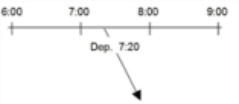For the timetable-based assignment, the temporal utility of a connection is included as a further skim value in the definition of impedance (PuT impedance functions).
Temporal utility means that the desired departure time of demand and the desired departure times of supply are considered. The same applies for the desired arrival time(s) of supply, when the arrival time is specified as the time reference of demand. This case is not explicitly described in the following.
The temporal utility of a connection depends on the following parameters:
- Desired departure time, which is indicated by the temporal distribution of demand
- Time difference ∆T between provided time of departure and desired time of departure
- Tolerance to differences between the provided time and the desired time of departure, which is called the sensitivity to earlier or later departures
In this way it can be modeled that also the temporal position of a connection has an effect on its attractiveness.
The temporal utility of a connection is highest for that interval in which the connection is placed, because then T = 0 applies. The higher ∆T, the lower the temporal utility.
For the timetable-based procedure, the temporal utility is included in the definition of impedance by adding ∆T to the perceived travel time and the sensitivity of passengers towards early or late departures can be set by parameter.
For both variants, the following applies.
The shorter the period between the actual departure time and the desired departure time, the higher the temporal utility of the connection and the lower its impedance.
|
Time series with hourly intervals ∆T (6-7) = 07:20 a.m. – 07:00 a.m. = 20 min ΔT (7-8) = 0 min ∆T (8-9) = 8:00 AM a.m. – 7:20 AM a.m. = 40 min |
|


